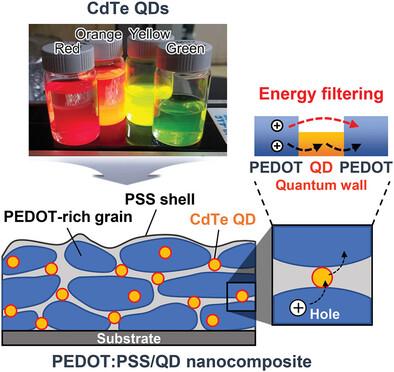当前位置:
X-MOL 学术
›
Adv. Electron. Mater.
›
论文详情
Our official English website, www.x-mol.net, welcomes your feedback! (Note: you will need to create a separate account there.)
Quantum‐Dot‐Induced Energy Filtering Effect in Organic Thermoelectric Nanocomposites
Advanced Electronic Materials ( IF 5.3 ) Pub Date : 2024-06-20 , DOI: 10.1002/aelm.202300814 Daegun Kim 1 , Jimin Kim 2 , Sein Chung 2 , Kilwon Cho 2
Advanced Electronic Materials ( IF 5.3 ) Pub Date : 2024-06-20 , DOI: 10.1002/aelm.202300814 Daegun Kim 1 , Jimin Kim 2 , Sein Chung 2 , Kilwon Cho 2
Affiliation

|
Thermoelectric (TE) charge transport in organic TE nanocomposite systems is a critical consideration in designing high‐performance TE materials. Here, the relationship between the TE properties and energy structure of conducting polymer/quantum dot (QD) nanocomposites is systematically investigated by developing a potential wall or potential well in poly(3,4‐ethylenedioxythiophene):poly(styrenesulfonate) (PEDOT:PSS) with CdTe QDs. The added QDs are primarily distributed within the electrically insulating PSS shell and act as stepping stones for charge transport between PEDOT‐rich grains. The embedded QDs generate an energy‐filtering effect, which is induced by both potential wall and potential well states established by the QDs in the PEDOT:PSS films. The induced energy‐filtering effect increases the Seebeck coefficient S with limited loss of electrical conductivity σ , thereby overcoming the TE trade‐off relation S ∝ σ −1/4 . The energy‐filtering effect is optimized by carefully controlling the QD size. The PEDOT:PSS/QD nanocomposite containing the smallest QDs exhibits a power factor of 173.8 µW m−1 K−2 , which is 80% larger than the value for the pristine PEDOT:PSS film. This work suggests a strategy for designing TE nanocomposites with improved TE performance and emphasizes the importance of fine‐tuning the interfacial energy gap to achieve an effective energy‐filtering effect.
中文翻译:

有机热电纳米复合材料中量子点诱导的能量过滤效应
有机 TE 纳米复合材料系统中的热电 (TE) 电荷传输是设计高性能 TE 材料的关键考虑因素。在这里,通过在聚(3,4-乙烯二氧噻吩):聚(苯乙烯磺酸)(PEDOT:PSS)中开发势壁或势阱,系统地研究了导电聚合物/量子点(QD)纳米复合材料的TE性质与能量结构之间的关系)与 CdTe 量子点。添加的量子点主要分布在电绝缘的 PSS 壳内,并充当富含 PEDOT 的颗粒之间电荷传输的垫脚石。嵌入的量子点产生能量过滤效应,这是由 PEDOT:PSS 薄膜中的量子点建立的势壁态和势阱态引起的。诱导的能量过滤效应增加了塞贝克系数 S,同时电导率 σ 的损失有限,从而克服了 TE 权衡关系 S ∝ σ -1/4。通过仔细控制量子点尺寸来优化能量过滤效果。含有最小量子点的 PEDOT:PSS/QD 纳米复合材料的功率因数为 173.8 µW m−1 K−2,比原始 PEDOT:PSS 薄膜的功率因数大 80%。这项工作提出了一种设计具有改进的 TE 性能的 TE 纳米复合材料的策略,并强调了微调界面能隙以实现有效的能量过滤效果的重要性。
更新日期:2024-06-20
中文翻译:

有机热电纳米复合材料中量子点诱导的能量过滤效应
有机 TE 纳米复合材料系统中的热电 (TE) 电荷传输是设计高性能 TE 材料的关键考虑因素。在这里,通过在聚(3,4-乙烯二氧噻吩):聚(苯乙烯磺酸)(PEDOT:PSS)中开发势壁或势阱,系统地研究了导电聚合物/量子点(QD)纳米复合材料的TE性质与能量结构之间的关系)与 CdTe 量子点。添加的量子点主要分布在电绝缘的 PSS 壳内,并充当富含 PEDOT 的颗粒之间电荷传输的垫脚石。嵌入的量子点产生能量过滤效应,这是由 PEDOT:PSS 薄膜中的量子点建立的势壁态和势阱态引起的。诱导的能量过滤效应增加了塞贝克系数 S,同时电导率 σ 的损失有限,从而克服了 TE 权衡关系 S ∝ σ -1/4。通过仔细控制量子点尺寸来优化能量过滤效果。含有最小量子点的 PEDOT:PSS/QD 纳米复合材料的功率因数为 173.8 µW m−1 K−2,比原始 PEDOT:PSS 薄膜的功率因数大 80%。这项工作提出了一种设计具有改进的 TE 性能的 TE 纳米复合材料的策略,并强调了微调界面能隙以实现有效的能量过滤效果的重要性。











































 京公网安备 11010802027423号
京公网安备 11010802027423号